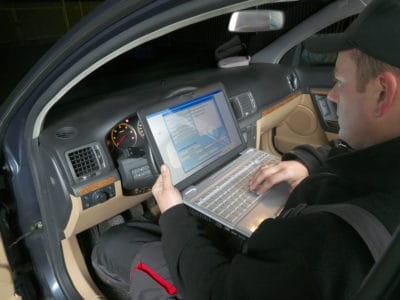A vehicle identification number, or VIN, is a unique code assigned to a new car which stays with it throughout the car’s life. The VIN, comprised of 17 characters, tells us a lot of useful information about a vehicle including its make and model, specifics regarding components and features, as well as its accident and maintenance history.
The VIN is used to track recalls, owner registration and insurance coverage, among other things throughout the lifespan of the vehicle.

What do the 17 VIN Characters Mean?
A car’s VIN is comprised of 17 capital letters and numbers, but these characters aren’t random, each of them tells us something important about the vehicle.
The first three numbers tell us the car’s country of origin and manufacturer. For example, cars made in the United States have a VIN that starts with 1, 4 or 5. Canadian cars begin with 2, Mexican vehicles have a 3, J for Japan, 9 for Brazil, L for China, etc. The code used for cars made by Toyota is JT, Mercedes-Benz is WDB, and GMC Truck USA is 1GT, just to name a few.
The following 5 characters give us a description of the car, including the vehicle’s brand, engine size and type. This part of the VIN holds a wealth of information. It tells us the car’s line type and model, body style, if it has a 2 wheel drive or 4 wheel drive transmission, the type of restraints included in the vehicle, it’s weight class, and more.
The 9th character is known as the check digit. It was adopted in the 1980s to combat VIN forgery. The check digit is essentially an equation which is used to validate the VIN. If the other VIN digits are correct, the check digit should be “X.” It’s calculated by substituting all the letters with their numeric equivalent. These numbers can then be multiplied by a weight factor table. Next, the numbers are added together and divided by 11. If the remainder equals 10, then the check digit is “X”.
The following two characters tell us the car’s model year and the plant where it was assembled. The model year is represented by a letter which is recycled every 30 years; for example, the letter A stands for 1980 and 2010, where the letter B is for 1981 and 2011. The final six digits are the vehicle’s unique serial number.
Where Is the VIN Located?
There are a few places to look if you want to find the vehicle identification number. Most likely it can be found on the car’s dashboard towards the driver’s side. From outside of the car, look where the dashboard meets the windshield. If you don’t see the VIN there, check on the edge of the driver’s side door where the door locks when closed.
Your car’s VIN should also be written clearly on the insurance card and policy documentation, the vehicle title and registration.
How Is the VIN Used?
The vehicle identification number was designed to act like a birth certificate for the car. Each car produced has its own unique number that it retains for its entire life. It’s most basic function is to identify a vehicle, especially if it has been abandoned or stolen.
Using the VIN, a car owner or prospective buyer can find the car’s comprehensive maintenance record, check if it has been involved in a major accident, see how many times it has been sold or even if it was stolen. For car collectors, for example, the VIN is a simple reference to check if the car has its original components.
An important function of the VIN is related to recalls; if there’s a problem with a particular make, model or even just a batch of cars, this number helps to easily identify the vehicles affected by a manufacturing recall. Similarly, the VIN is required for warranty claims.
Your body shop will likely request your VIN when preparing an estimate or carrying out repair work. They do this for a few reasons. Because the VIN tells us so much about the car, it’s useful for planning repairs and ordering the right replacement parts. The body shop keeps track of the vehicles that it works on in case the owner or technician need to know what work has been done in the past. They can also use the VIN to verify if there are any recalls or service recommendations for that particular car.
Car insurance companies rely on the VIN to evaluate the safety standards and operational risks associated with your vehicle. This is how insurance coverage is calculated at a higher rate for cars with larger engines. Have More Questions About Your Car?
Ask the experienced technicians at Badell’s Collision. Our auto body shop has served the Aston, Pennsylvania area for over 90 years. For all of our services, we believe in getting it done right…not fast. Call us at (610) 497-8887 or request an estimate today.




